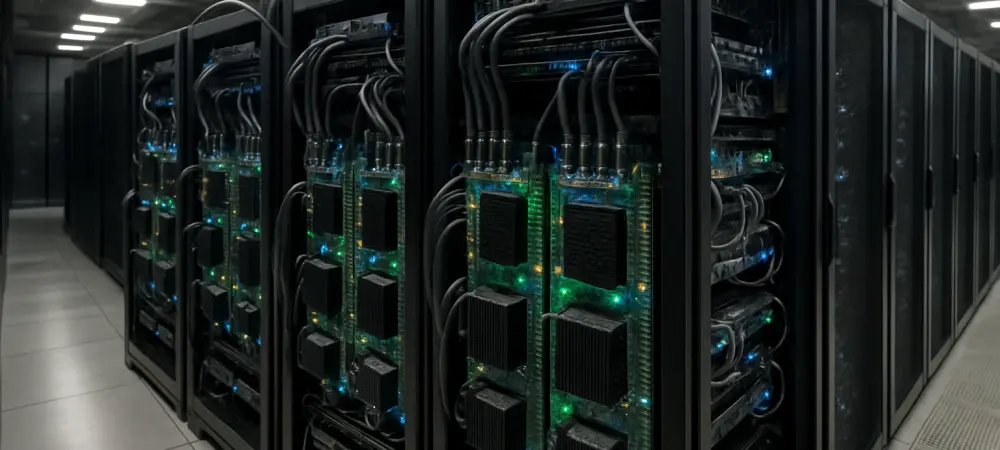Navigating the Data Center Crisis in 2025
In the heart of the digital economy, data centers are grappling with an unprecedented storm of complexity as artificial intelligence (AI) and high-performance computing (HPC) workloads skyrocket, creating immense pressure on infrastructure. A staggering statistic sets the stage: modern inference tasks for AI models can demand up to 100 times the resources of traditional models, pushing systems to their breaking point. This escalating demand, coupled with a fragmented ecosystem of hardware accelerators, has created a perfect storm of operational chaos, unsustainable power consumption, and spiraling costs. This market analysis delves into the current state of the data center industry, examining how these challenges are reshaping operational strategies and spotlighting reconfigurable computing as a potential lifeline. By exploring key trends, data points, and future projections, the aim is to provide clarity on whether this adaptive technology can redefine efficiency and sustainability in an AI-driven world.
Market Trends and Insights Shaping Data Center Operations
The Surge of AI and HPC Workloads
The data center market is undergoing a seismic shift driven by the relentless growth of AI and HPC applications. As industries pivot toward innovation fueled by transformer architectures and agentic AI systems, workloads have evolved beyond predictable patterns, blurring the lines between training and inference processes. This transformation means that tasks once considered lightweight now require massive computational resources, often distributed across multiple devices through sharding techniques. Industry reports indicate that the scale of foundational pretraining and compute-intensive test-time scaling has introduced new layers of demand, with some models necessitating infrastructure adjustments on a scale unseen just a few years ago. This trend shows no sign of slowing, as projections suggest a continued upward trajectory in workload complexity through at least 2027, challenging operators to rethink traditional hardware reliance.
Power Consumption: A Looming Economic and Environmental Burden
A critical pain point in the market is the unsustainable power consumption tied to hardware heterogeneity. Specialized accelerators, consuming between 1,400 and 2,000 watts per device, have driven rack densities to as high as 600 kW, far surpassing the typical 10-20 kW capacity of conventional setups. High-profile projects, such as those requiring power equivalent to a mid-sized U.S. city—up to 1.21 GW—highlight the severity of this issue. Inefficiencies in traditional architectures further exacerbate the problem, with energy waste from memory fetch loops accounting for 40-60% of total consumption. This not only inflates operational costs but also raises environmental concerns, pushing stakeholders to prioritize energy-efficient solutions as a competitive necessity in a market increasingly scrutinized for sustainability.
Hardware Diversity Driving Operational Inefficiencies
Another defining trend is the operational complexity introduced by a diverse hardware ecosystem. The integration of GPUs, ASICs, and other accelerators, each with unique memory spaces and vendor-specific development environments, creates a fragmented landscape that is challenging to manage at scale. For example, orchestrating an AI pipeline across multiple device types often involves navigating several memory coherence protocols, leading to significant overhead and potential points of failure. Market analysis reveals that this “chip-per-task” approach, while offering tailored performance for specific workloads, often results in logistical bottlenecks that diminish overall gains. Operators are thus caught in a balancing act, weighing short-term performance boosts against long-term scalability and cost concerns.
The Resource Allocation Conundrum
Resource allocation remains a persistent hurdle, often referred to in industry circles as the “matchmaker’s dilemma.” With AI models relying on sharding to distribute workload fragments, matching these pieces to optimal hardware—whether for processing power, memory bandwidth, or interconnect capabilities—has become a complex puzzle. Static hardware assignments fail to adapt to fluctuating demands, leading to inefficiencies and underutilized resources. Current heterogeneous solutions, while attempting to address this through diverse accelerators, often deepen the complexity by requiring manual orchestration. Market forecasts suggest that without a shift to more dynamic allocation methods, this dilemma will continue to hinder performance and drive up costs, creating an urgent need for innovative approaches.
Reconfigurable Computing: A Rising Market Opportunity
Amid these challenges, reconfigurable computing emerges as a transformative force in the data center market. Unlike fixed-function hardware, these systems can adapt data paths and execution units in nanoseconds to suit specific workload needs, offering a flexible alternative to rigid designs. Early adopters report potential reductions in power consumption by minimizing inter-chip communication and memory fetch inefficiencies, alongside simplified operations through consolidated compute functions. Market projections indicate growing interest in this technology, with compatibility features supporting existing frameworks like CUDA and OpenCL positioning it as a scalable solution. While adoption barriers such as initial costs and industry inertia persist, the promise of future-proof infrastructure makes this a segment to watch closely over the coming years.
Reflecting on Market Implications and Strategic Pathways
Looking back, this analysis uncovered the profound challenges that define the data center market, from the overwhelming demands of AI and HPC workloads to the inefficiencies of power-hungry, heterogeneous hardware ecosystems. The exploration revealed how operational complexity and resource allocation struggles compounded these issues, painting a picture of an industry at a critical juncture. Reconfigurable computing stood out as a beacon of potential, offering adaptability that addressed many root causes of inefficiency and chaos. Moving forward, stakeholders are encouraged to consider strategic investments in pilot projects for reconfigurable systems, targeting workloads with high variability to test integration and benefits. Collaboration with technology providers to ensure software compatibility emerges as a key step, alongside training initiatives to equip teams with necessary skills. By shifting focus from accumulating more specialized hardware to embracing intelligent, adaptive solutions, the industry positions itself to not only mitigate current burdens but also build resilience against future demands. This strategic pivot promises to chart a sustainable path in a landscape increasingly shaped by digital innovation.

